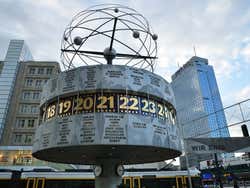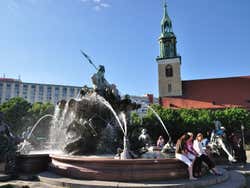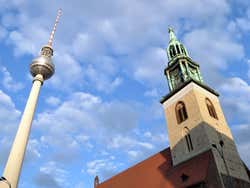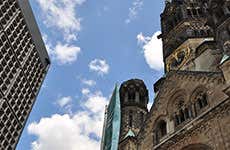
Alexanderplatz
Alexanderplatz has been considered the heart of Berlin since the Middle Ages. Learn about the history of the most touristic square in Berlin, home to the TV Tower and the famous World Clock.
Situated in the central district of Berlin, this public square has always been the hub of the capital. During the medieval period, a cattle market “Ochsenmarkt” was located in the plaza. In the 1920s, it became the place to go out at night. Nowadays, many Berliners nickname it “Alex”, and it is one of the main meeting points in the city.
Alexanderplatz During the Cold War
The area was completely devastated by the air bombing at the end of World War II. Situated in East Berlin, the German Democratic Republic restored the square, transforming it into the nerve center of this part of the city.
As part of the plan to reform the area, East Germany extended the square and made it pedestrian in the 1960s. To demonstrate the power of the GDR, the Television Tower (Fernsehturm) was erected. To this day, it is one of the tallest monuments in Europe.
On 4 November 1989 Alexanderplatz witnessed unprecedented protests; half a million people went out on the streets to protest against the communist regime. Five days later, on 9 November, the German Democratic Republic announced the opening of East Berlin-West Berlin borders.
Alexanderplatz Nowadays
If you walk to the TV Tower from the city center, you will probably think that Alexanderplatz is the square that houses the Tower, but the “original” square is just behind the monument. Nowadays, both parts of the square are considered the modern Alexanderplatz.
The large square is home to several trendy bars and the Galeria Kaufhof, a shopping center like the Spanish “Corte Inglés”. Another highlight is the World Time Clock with the globe's 24 time zones. You will also appreciate the Fountain of Friendship Between Peoples. Both monuments were added in 1969.
The square to the west of the Tower houses three interesting monuments: St. Mary’s Church (Marienkirche) established in 1380, Neptune Fountain (Neptunbrunnen) and the Red Town Hall (Rotes Rathaus) given this name because of its outer red brick. It is the current headquarters of the Senate of Berlin.
Two large avenues designed during the communist period set off from Alexanderplatz. It is worth mentioning Karl-Marx-Allee, a large avenue with Soviet-style buildings.



Transport
U-Bahn: Alexanderplatz, lines U2, U5 and U8.
Train:Alexanderplatz, lines S5, S7, S9 and S75.
Bus: Alexanderplatz, lines TXL, M48, 100, 200 and 248.
Tram: M4, M5 and M6.
Nearby places
TV Tower (284 m) DDR Museum in Berlin (797 m) Berlin Cathedral (879 m) Alte Nationalgalerie in Berlin (1 km) Altes Museum in Berlin (1 km)
